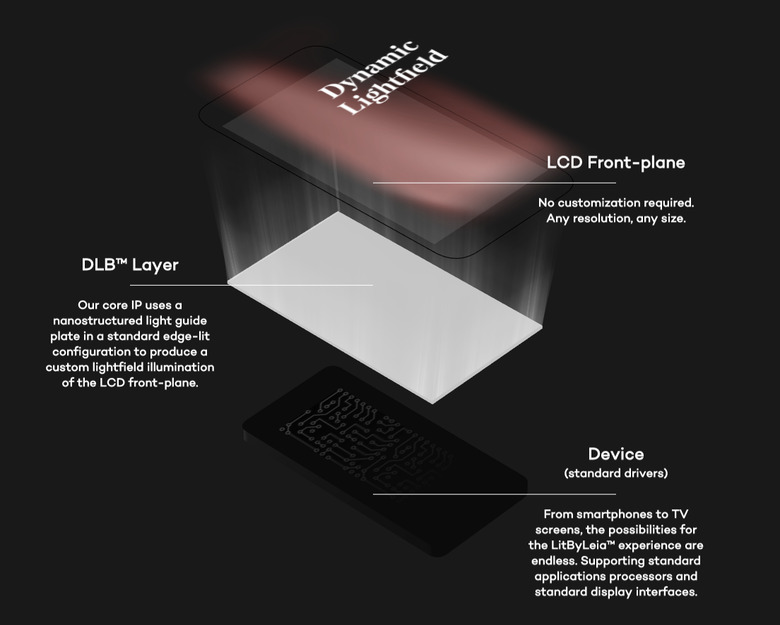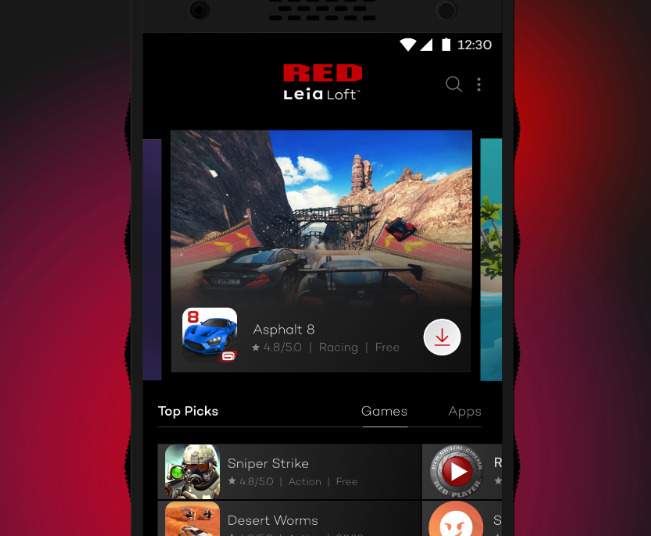Interview: LEIA Inc Founder On RED Phone's Radical Display
This week we spoke with one of the founders of LEIA Inc, David Fattal, on the big deal behind the next-gen DLB tech with Lightfield Mode for a new type of 3D. This technology's been in development for over a half-decade, starting its life with Fattal and crew at HP Labs in Palo Alto. Now their display technology's about to hit the market in a smartphone that's set to appear on shelves on two of the country's biggest mobile carriers. This display's about to be in front of thousands if not millions of everyday citizens. What's the big deal?
RED Hydrogen One's display: Created by Leia
The folks at RED are about to release their RED Hydrogen One, a smartphone the likes of which have never before been seen. This smartphone has a massive set of 3D-capable cameras on its back, a body that's surrounded by rubbery-ribbed finger-intends, and a display up front that's extraordinary. With Leia's technology and software, this machine becomes another level of unique.
We've seen 3D-like displays in the past in devices like the HTC Evo 3D and the Nintendo 3DS. What makes the Leia solution different?
"Leia's Diffractive Lightfield Backlighting (DLB) technology," said Fattal, "provides the key ability to switch seamlessly between a regular '2D Mode' where the display operates at its maximum resolution (2560x1440 in the case of Hydrogen) with no visible surface artifacts or loss of brightness, [and] a novel 'Lightfield Mode' where it is able to send up to 16 different images at the same time towards the viewer."
"[Leia's display tech] offers natural sense of depth and some 'look-around effect' without the need for extra eye-wear, said Fattal. "[It] uniquely enables the rendering of complex light effects, lens flares, light shafts and other specular reflections. [It] makes textures like skin, leather, wood, or metallic surfaces look unprecedently [sic] real."

"All of the above works in both portrait and landscape mode," said Fattal. "In comparison previous '3D' technologies available on mobile devices offeRED a limited 2 views (left eye / right eye — producing depth but none of the other effects described above) and either permanently degraded the resolution of the device or presented visible optical artifacts in 2D mode when available."
How do you work with display manufacturers and manufacturers of final constructed products – like RED for this Hydrogen One smartphone?
"Display manufacturers are actually our suppliers," said Fattal. "We take the best of what's already available in the industry and complement it with our nanotechnology and assembly processes to deliver the final, upgraded display module to our customers or to use in our own products."

"Nanotechnology design and mass-manufacturing is only one side of the company," said Fattal. "We also enable and support a widening ecosystem of lightfield content through our developer program, video processing tools and app store LeiaLoft, or by publishing original apps such as Holopix for the social sharing of lightfield pictures."
"The unique combination of Hardware and Software developed at Leia helps us deliver the very best experience to end users while relentlessly driving innovation for our supply chain and ourselves."
What can lightfield design do now? The RED phone will have a full-display lightfield display, but could a lightfield cover just a small part of a display? Could your tech make a smartphone more complex than the RED phone?
The current DLB design lets the Hydrogen phone switch seamlessly between a pristine '2D Mode' and the novel 'Lightfield Mode,'" said Fattal. "In the lab we are currently working on a 'Mixed Mode' where 2D and Lightfield content will coexist on the screen at any desiRED location — commercialization still TBD."
Are you working with companies other than RED to incorporate your tech in their future products? What sorts of products are in the pipeline as of now?
"Indeed we have a commercial play as well and partner with companies in the automotive, medical and retail space," said Fattal.
Get your eyes and hands on this
It seems that it's difficult to demonstrate your tech via the web. How do you plan on expanding the effectiveness of explaining or experiencing your display tech in the future – all offline, in person?
"With the Hydrogen program, US customers will very soon be able to experience Leia's technology in any major AT&T or Verizon store — and the rest of the world will follow shortly after," said Fattal. "Leia is a new medium that creates a strong emotional connection to content. It absolutely needs to be experienced in person."
Extended Coverage
Stick around as SlashGear gets closer to the source – and helps you, the reader, understand how this next-gen display technology could potentially impact your everyday life. Meanwhile head over to an AT&T or a Verizon store to see the RED Hydrogen One in full effect starting at the tail end of October.
